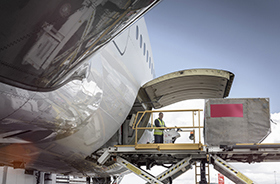Tuesday, March 12, 2024

At the IATA World Cargo Symposium’s commencement, the International Air Transport Association (IATA) evaluated advancements in digitalization, safety, and sustainability, targeting the acceleration of progress in these key areas.
“Air cargo volumes are now firmly back to pre-pandemic levels. The challenge now is to ensure that air cargo growth is efficient, safe and aligned with achieving net zero carbon emissions by 2050. Through the hard work of the air cargo industry, the building blocks are in place to significantly accelerate progress in all these areas,” said Brendan Sullivan, IATA’s Global Head of Cargo at the World Cargo Symposium (WCS), which opened in Hong Kong, today
Digitalization
“The biggest opportunity for the air cargo industry is digitalization. This has not happened as fast as any of us would have liked. But progress is real. Inefficient paper-based, manual processes are being replaced with digital solutions in all aspects of cargo operations from tracking to customs clearance. That’s a fact. And it’s making international trade more efficient. Our call to action is clear: Governments must consistently implement global standards, supply chain partners need to collaborate to overcome shared challenges, and the entire industry must align to ensure a unified and effective approach to digitalization,” said Sullivan.
Progress was showcased in three main areas:
“Safety is critical to air cargo’s success. Last year the industry’s safety record reached new heights. Among the 38 million flights in 2023 there were 30 accidents, just one of which was fatal. A good safety record is earned every day. For air cargo that means continuing to put special emphasis on the handling of dangerous goods, and in particular lithium batteries,” said Sullivan.
Key developments in ensuring the safe transport of lithium batteries include:
The foundation of these safety measures is the IATA Dangerous Goods Regulations (DGR), crucial for air cargo operators handling dangerous goods. In early 2024, IATA reinforced its collaboration with ICAO to publish this vital guide. The industry is also embracing innovative solutions like the Connect API and DG AutoCheck, which streamline traditional paper-based procedures, demonstrating the advantages of digital transformation in enhancing safety protocols.
Sustainability
Airlines and shipping companies have shown strong interest in adopting Sustainable Aviation Fuels (SAF), which are projected to contribute significantly, about 65%, to the reduction measures required to reach a net-zero carbon emissions goal by 2050.
Airlines and shippers have given strong demand signals for Sustainable Aviation Fuels (SAF) which are expected to account for some 65% of the needed mitigation to achieve net zero carbon emissions in 2050.
“There is no shortage of demand signals from airlines and shippers to use SAF. The problem remains a shortage of supply. As we saw with the introduction of solar and wind generation for electricity, production incentives are the way forward. Japan is a good example. The government has put a 10% production mandate on fuel suppliers. Singapore has also recently taken steps to create a Sustainable Air Hub with a view to foster SAF production and use. The US is another with tax credits embedded in the Inflation Reduction Act that are resulting in increased production. We need more governments to follow these positive examples,” said Sullivan.
In addition, this year will see the introduction of CO2 Connect for cargo, an innovative tool designed for precise emissions calculation from operations. The IATA Environmental Assessment (IEnvA) program is assisting 60 industry organizations, including airlines, airports, and cargo handlers, in showcasing their sustainability efforts and their beneficial impact on the sector.
“For any industry to survive, change is essential. And constant change for anyone is never easy. But it is absolutely worth it when that change delivers 60 million tonnes of cargo that powers economies, improves peoples’ lives and genuinely makes our world a better place. And that is what inspires us to make our industry more efficient, ever safer and on target for net zero carbon emissions by 2050,” said Sullivan.
Saturday, April 27, 2024
Saturday, April 27, 2024
Sunday, April 28, 2024